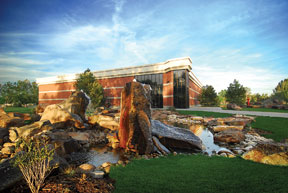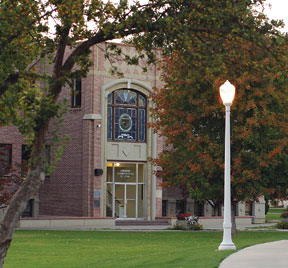
Learning within ‘community’ is just as strong as residential-based instruction.
By Jay R. Akkerman
 With unemployment rising sharply and national budget deficits ballooning to their worst level since the Great Depression, many feared the country’s looming economic calamity. While this scenario seems fresh from today’s headlines, the setting was actually in 1982. And the futurist who thumbed his nose at pundits was John Naisbitt, author of the bestselling Megatrends, a business and leadership classic that was hailed for more than two decades as a roadmap into the 21st century. Naisbitt won acclaim for anticipating 10 far-reaching business and cultural trends. Today’s Christian leaders face new challenges in a world marked by economic, technological, and cultural changes. A growing number of women and men are responding to God’s leading with an eye to the future. But many who would have once been seminary-bound now find it increasingly difficult to pull up stakes.
With unemployment rising sharply and national budget deficits ballooning to their worst level since the Great Depression, many feared the country’s looming economic calamity. While this scenario seems fresh from today’s headlines, the setting was actually in 1982. And the futurist who thumbed his nose at pundits was John Naisbitt, author of the bestselling Megatrends, a business and leadership classic that was hailed for more than two decades as a roadmap into the 21st century. Naisbitt won acclaim for anticipating 10 far-reaching business and cultural trends. Today’s Christian leaders face new challenges in a world marked by economic, technological, and cultural changes. A growing number of women and men are responding to God’s leading with an eye to the future. But many who would have once been seminary-bound now find it increasingly difficult to pull up stakes.
Other more seasoned Christian leaders are also looking for new handles to strengthen their ministries in churches and communities that have morphed seemingly before their very eyes. What educational options are available for leaders who have no sense of release from their current ministry settings?
New learning models
When residential programs are impossible or the cost of travel, lodging, and time away from home and work make modular programs difficult, what learning models are available to burgeoning and established Christian leaders? In growing numbers today, online education is proving to be a helpful way for men and women to respond to God’s call and to engage their ministries in meaningful mission. Many today are surprised by the advantages of online education, which has evolved greatly from unaccredited correspondence courses to much more academically robust degree programs offered by accredited educational institutions. For many students today, online is “Face Time 2.0.” Prior to joining the faculty at Northwest Nazarene, I served for many years as lead pastor and staff member in several dynamic congregations. My ministry in these settings had been shaped in no small way by classroom educators at the college and seminary level who invested themselves in me personally. In 2002 while still in the pastorate, I was asked by NNU to teach a spiritual formation course as an online graduate adjunct.
 To be honest, my knee-jerk reaction to the proposal was less than enthusiastic. Initially, online education seemed somehow less personal to me. It took me outside the comfort zone of the classroom encounters I had known as a student and into other venues where I had served as an instructor. Community is still important; I soon discovered two important lessons: first, I was not alone; and second, I was wrong about my perceptions. Like me, all of the adult students in my first course were also new to online education. As a theological educator with experience in both the classroom and online, I have found community to be an important megatrend for those in our fully online Master of Divinity and Master of Arts programs. While individualized correspondence courses are abundant on the Internet, NNU has made a commitment to ground student learning in a relational model: students progress through their programs together, one course at a time. Thriving as colleagues in their learning communities, my students are neither lone rangers nor competitors vying against each other in the classroom. NNU’s learning communities model a formula Naisbitt called “high tech/high touch.” The author observed in Megatrends: “Whenever new technology is introduced into society, there must be a counter balancing human response — that is, high touch — or the technology is rejected. The more high tech, the more high touch.” In my experience, students in our online learning communities experience as much — and possibly even more — community as students in traditional residential-based seminaries. Given that so many seminaries must now offer block classes a day or two a week to accommodate busy student schedules, these traditional campuses often become commuter islands with little time available for the development of meaningful community between students and faculty. But consider three examples as alternatives:
To be honest, my knee-jerk reaction to the proposal was less than enthusiastic. Initially, online education seemed somehow less personal to me. It took me outside the comfort zone of the classroom encounters I had known as a student and into other venues where I had served as an instructor. Community is still important; I soon discovered two important lessons: first, I was not alone; and second, I was wrong about my perceptions. Like me, all of the adult students in my first course were also new to online education. As a theological educator with experience in both the classroom and online, I have found community to be an important megatrend for those in our fully online Master of Divinity and Master of Arts programs. While individualized correspondence courses are abundant on the Internet, NNU has made a commitment to ground student learning in a relational model: students progress through their programs together, one course at a time. Thriving as colleagues in their learning communities, my students are neither lone rangers nor competitors vying against each other in the classroom. NNU’s learning communities model a formula Naisbitt called “high tech/high touch.” The author observed in Megatrends: “Whenever new technology is introduced into society, there must be a counter balancing human response — that is, high touch — or the technology is rejected. The more high tech, the more high touch.” In my experience, students in our online learning communities experience as much — and possibly even more — community as students in traditional residential-based seminaries. Given that so many seminaries must now offer block classes a day or two a week to accommodate busy student schedules, these traditional campuses often become commuter islands with little time available for the development of meaningful community between students and faculty. But consider three examples as alternatives:
Keegan is a gifted youth pastor in a large California megachurch. Shortly after entering our program, he and his wife were devastated when their infant son was diagnosed with cancer. “I began asking myself, ‘Can I continue on with this degree while dealing with the hospital and trying to work full-time?’ NNU’s staff and faculty were highly supportive, constantly sending me emails saying, ‘Our team lifted you up in prayer today.’ There was a lot of grace shown to me which enabled me to continue on in the program and finish on time.”
 Despite the fact that Simon serves in ministry in Bangalore, India on the opposite side of the globe from most of his professors and fellow students, the asynchronous design of our programs enabled him to log in and participate in course-related dialogue at the time of day that fit his schedule.
Despite the fact that Simon serves in ministry in Bangalore, India on the opposite side of the globe from most of his professors and fellow students, the asynchronous design of our programs enabled him to log in and participate in course-related dialogue at the time of day that fit his schedule.
Lane was seemingly in the latter chapters of his ministry when he entered our fully online program. He now reflects on how his online course work compressed the gap between theory and practice, noting that “the opportunity for fleshing out what I had learned was exciting.”
Today, I am continually reminded that my online students are so much more than mere words or even an image on my computer screen.
Dr. Jay Richard Akkerman is associate professor of preaching and missional theology at Northwest Nazarene University in Nampa, ID, where he also directs the university’s graduate theological online education programs. www.nnu.edu/online


